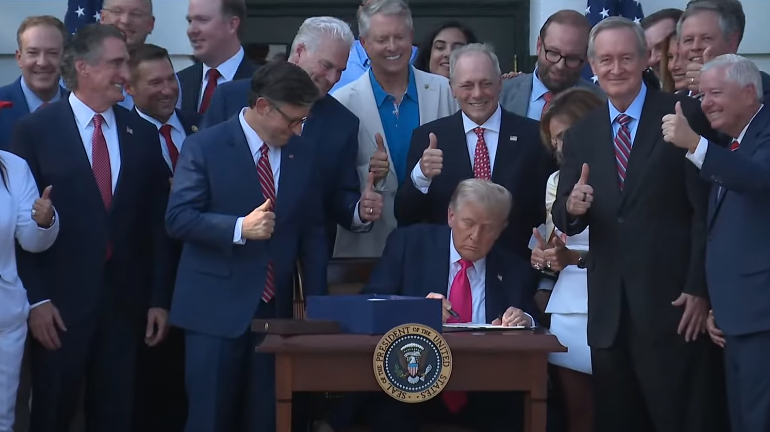
Following the House and Senate completing their work on the One Big Beautiful Bill Act, enacting much of President Donald Trump’s legislative agenda as he signed it into law on July 4, Democrats are now shifting their posture towards the 2026 Congressional midterms with an eye to reclaiming the House and Senate by campaigning against the bill’s provisions.
Not a single Democrat in the House or Senate voted for the One Big Beautiful Bill Act, which makes the 2017 Trump tax cuts permanent, expands tax relief with no income taxes on tips or overtime, cuts income taxes for seniors collecting Social Security, includes 100 percent expensing for factories and agriculture to encourage domestic production, $170 billion of border and immigration enforcement provisions, including $46 billion to finish the border wall, $45 billion for new immigration detention centers that can deal with 116,000 detainees, knocks 1.4 million illegal aliens off of Medicaid and food stamps, 10,000 new Immigration and Customs Enforcement officers, a $10,000 signing bonuses for Border Patrol agents as well, $1 billion for the Department of Defense for border security and $10 billion for states to assist federal immigration enforcement efforts.
For President Trump it was his biggest legislative win ever, and will give his administration and Congress some breathing room on the debt ceiling, which was increased by $5 trillion, taking that off the list of “must-pass” bills that will come up again in the next couple years. The remaining bills will include appropriations, whether in the form of individual appropriations bills, an omnibus bill or another continuing resolution. These are leverage points that will cause President Trump and Republican leaders in Congress to sit down with Democrats to craft presumably stopgap deals to kick the can ahead.
Section 702 of the Foreign Intelligence Surveillance Act (FISA) will expire on April 29, 2026, another leverage point but also an opportunity for reform, assuming there’s a bipartisan appetite for that. New disclosures from the 2016 Russiagate fiasco showing partisan dirty tricks against Trump, falsely accusing him of being a Russian agent, that might help or hinder those efforts as Democrats circle the wagons.
There is also the National Defense Authorization Act that comes up every year that usually passes with fairly strong bipartisan majorities that nonetheless will still require haggling between Republicans and Democrats to get to 60 votes in the Senate.
Also, with Supreme Court Justices Clarence Thomas (77 years old) and Samuel Alito (75 years old), the oldest serving members of the nation’s highest court appointed by Republicans, a somewhat customary practice is for older members to retire while the party that appointed them remains in power, creating a potential window for President Trump to appoint their replacements. If those retirements are imminent, expect them to occur within the next year.
In the meantime, despite all of the action in Congress and what remains ahead, not much at all has changed with the generic Congressional ballot for 2026, only leading by 2.3 percentage points, 45 percent to 42.7 percent, according to the latest average compiled by RealClearPolling.com.
Usually a reliable proxy for which direction the country is headed in, the average of generic Congressional ballot polls all predicted the winner of the 2002, 2006, 2010, 2014, 2018 and 2022 midterm elections.
In 2002, the Real Clear Politics average of the last batch of polls taken had Republicans winning the popular vote 47.7 percent to 46 percent, and sure enough Republicans won the popular vote for the House of Representatives, except that it was by an even greater margin than forecast, 49.6 percent to 45 percent.
In 2006, the average of polls had Democrats leading the generic Congressional ballot 52.1 percent to 40.6 percent, although that overstated the outcome a bit, with Democrats winning the House popular vote 52 percent to 44 percent.
In 2010, the average of polls had Republicans leading 50.7 percent to 41.3 percent, also overstated a bit, with the final outcome being 51.6 percent to 44.8 percent.
In 2014, the average of polls had Republicans ahead, 45.6 percent to 43.2 percent, and Republicans won with 51.4 percent to 45.7 percent.
In 2018, the average of polls had Democrats ahead, 49.7 percent to 42.4 percent, and Democrats won with 53.3 percent to 44.9 percent.
And in 2022, the average of polls had Republicans ahead 48 percent to 45.5 percent, and Republicans won 50.6 percent to 47.8 percent.
In midterm elections dating back to 1906 through 2022, the party that occupied the White House lost seats in the House 27 out of 30 times, or 90 percent of the time, and in years with losses those averaged 34 seats. It was only overcome in 1934, 1998 and 2002, with the Great Depression, Monica Lewinsky and the Sept. 11, 2001 terrorist attacks acting as exigent events. Another edge case is 1962, wherein Democrats only lost three seats, and came within weeks of the Cuban Missile Crisis being resolved.
The general rule favoring the opposition in midterms is all James Madison’s constitutional scheme of periodic elections, explicitly designed to frustrate the ability of majorities to get things done. But midterms are generally a turnout affair, where the opposition party, being out of power, simply has more a motivation to vote, and so they tend to do relatively better, picking up seats, but not always majorities.
To do that, the popular vote itself a reliable gauge of who won the majority. In 28 out of 30 midterm elections, or 93 percent of cases, the party that won the national popular vote for the House also won the majority for the House of Representatives, in 1906, 1910, 1918, 1922, 1926, 1930, 1934, 1938, 1946, 1950, 1954, 1958, 1962, 1966, 1970, 1974, 1978, 1982, 1986, 1990, 1994, 1998, 2002, 2006, 2010, 2014, 2018 and 2022.
The only exceptions were 1914, when Republicans won the popular vote but not a House majority, and 1942, when the same thing happened, both owing to the 100+ seat majorities Democrats had acquired in 1912 and 1940, respectively, giving them the overwhelming odds Democrats would retain House majorities no matter how poorly they did in the election.
So, that’s the advantage wielded generally by the opposition power during Congressional midterms, which might make Democrats’ current narrow margin in the generic ballot somewhat worrisome. On average, Trump still has his highest approval of his entire political career at 46.5 percent — higher than in 2017, 2018, 2019 and 2020 — while public approval of Democrats generally has been cratering.
Expect Republicans to emphasize their advantage on issues like illegal immigration, the border and social issues including the participation of biological males in female sports.
Inflation, still the top issue among voters, continues its three-year decline and so if anything could look good for Trump and Republicans, provided incomes and wages continuing outpacing any consumer price increases. Other economic headwinds might come in the form of higher unemployment, a slowdown or even a recession, while labor shortages might mitigate any downturn.
There are exigent factors again that can impact how the midterms go, and then there is the traditional advantage the opposition party wields, both of which can either be at tension with one another or moving in the same direction. If the latter, and Democrats may have a very good cycle, but if the former, as the polls currently indicate it is close, then Republicans might be able to pull of an upset. Stay tuned.
Robert Romano is the Executive Director of Americans for Limited Government Foundation.






